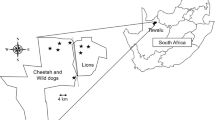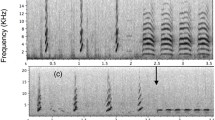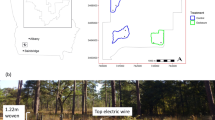Summary
Belding's ground squirrels (Spermophilus beldingi) give acoustically distinct alarm calls to aerial and terrestrial predators. The animals typically give multiple-note trills to predatory mammals, and single-note whistles to flying hawks. During a 9-year study of free-living S. beldingi at Tioga Pass, California, the adaptive significance of the whistle call was investigated. Data were gathered on 664 ground squirrel-hawk interactions, most of which were induced by flying trained raptors over individually marked study animals of known sex and age. The sight of a flying hawk and the sound of whistles stimulated widespread calling and running to shelter by the ground squirrels (Fig. 1). Wild raptors were rarely successful at capturing the rodents once a whistle had been given, and fewer callers than noncallers were killed (Table 1). Individuals of both sexes and all ages whistled equally often (Fig. 4), and females' tendencies to whistle were not affected by the presence of relatives, including offspring (Fig. 5). The most frequent callers were animals in exposed positions: far from cover and close to the predatory bird (Table 2). Taken together the data suggest that unlike trills, which increase vulnerability to terrestrial predators (Table 1) and function to warn relatives, whistle directly benefit callers by increasing their chances of escaping from hawks.
Similar content being viewed by others
References
Balph DM, Balph DF (1966) Sound communication of Uinta ground squirrels. J Mammal 47:440–450
Barash DP (1975) Marmot alarm-calling and the question of altruistic behavior. Am Midl Nat 94:468–470
Barash DP (1976) Social behaviour and individual differences in free-living alpine marmots (Marmota marmota). Anim Behav 24:27–35
Batschelet E (1981) Circular statistics in biology. Academic Press, New York
Brown CH (1982) Ventroloquial and locatable vocalization in birds. Z Tierpsychol 59:338–350
Charnov EL, Krebs JR (1975) The evolution of alarm calls: altruism or manipulation? Am Nat 109:107–112
Cheney DL, Seyfarth RM (1981) Selective forces affecting the predator alarm calls of vervet monkeys. Behaviour 76:25–61
Davis LS (1984) Alarm calling in Richardson's ground squirrels (Spermophilus richardsonii). Z Tierpsychol 66:152–164
Dobson FS (1982) Competition for mates and predominant juvenile male dispersal in mammals. Anim Behav 30:1183–1192
Drabek CM (1970) Ethoecology of the round-tailed ground squirrel, Spermophilus tereticaudus. PhD thesis, University of Arizona, Tucson
Dunford C (1977) Kin selection for ground squirrel alarm calls. Am Nat 111:782–785
Evans FC (1951) Notes on a population of the striped ground squirrel (Citellus tridecemlineatus) in an abandoned field in southeastern Michigan. J Mammal 32:437–449
Fitch HS (1948) Ecology of the California ground squirrel on grazing lands. Am Midl Nat 39:513–596
French AR (1982) Intraspecific differences in the pattern of hibernation in the ground squirrel Spermophilus beldingi. J Comp Physiol 148:83–91
Greenwood PJ (1980) Mating systems, philopatry and dispersal in birds and mammals. Anim Behav 28:1140–1162
Hamilton WD (1964) The genetical evolution of social behaviour, I and II. J Theor Biol 7:1–52
Hamilton WD (1971) Geometry for the selfish herd. J Theor Biol 31:295–311
Hanken J, Sherman PW (1981) Multiple paternity in Belding's ground squirrel litters. Science212:351–353
Harris MA, Murie JO, Duncan JA (1983) Responses of Columbian ground squirrels to playback of recorded calls. Z Tierpsychol 63:318–330
Holekamp KE (1983) Proximal mechanisms of natal dispersal in Belding's ground squirrel (Spermophilus beldingi beldingi). PhD thesis, University of California, Berkeley
Holekamp KE (1984a) Natal dispersal in Belding's ground squirrels (Spermophilus beldingi). Behav Ecol Sociobiol 16:21–30
Holekamp KE (1984b) Dispersal in ground-dwelling sciurids. In: Murie JO, Michener GR (eds) The biology of ground-dwelling squirrels. University of Nebraska Press, Lincoln, Neb, pp 297–320
Holmes WG, Sherman PW (1982) The ontogeny of kin recognition in two species of ground squirrels. Am Zool 22:491–517
Hoogland JL (1983) Nepotism and alarm calling in the blacktailed prairie dog (Cynomys ludovicianus). Anim Behav 31:472–479
Humphries DA, Driver PM (1970) Protean detense by prey animals. Oecologia (Berl) 5:285–302
Ivins BL, Smith AT (1983) Responses of pikas (Ochotona princeps. Lagomorpha) to naturally occurring terrestrial predators. Behav Ecol Sociobiol 13:277–285
Jenkins SH, Eshelman BD (1983) Spermophilus beldingi.Am Soc Mammal, Mammalian Sp 221:1–8
Koeppl JW, Hoffmann RS, Nadler CF (1978) Pattern analysis of acoustical behavior in four species of ground squirrels. J Mammal 59:677–696
Krebs JR, Dawkins R (1984) Animal signals: mind reading and manipulation. In: Krebs JR, Davies NB (eds) Behavioural ecology, 2nd edn. Sinauer, Sunderland, Mass, pp 380–402
Leger DW, Owings DH (1978) Responses to alarm calls by California ground squirrels: effects of call structure and maternal status. Behav Ecol Sociobiol 3:177–186
Leger DW, Owings DH, Boal LM (1979) Contextual information and differential responses to alarm whistles in California ground squirrels. Z Tierpsychol 49:142–155
Leger DW, Owings DH, Gelfand DL (1980) Single-note vocalizations of California ground squirrels: graded signals and situation-specificity of predator and socially evoked calls. Z Tierpsychol 52:227–246
Leger DW, Berney-Key SD, Sherman PW (1984) Vocalizations of Belding's ground squirrels (Spermophilus beldingi). Anim Behav 32:753–764
Mader WJ (1975) Biology of the Harris' hawk in southern Arizona. Living Bird 14:59–85
Markl H (1985) Manipulation, modulation, information, cognition: some of the riddles of communication. Fortschr Zool 31:163–194
Marler P (1955) Characteristics of some animal calls.Nature 176:6–8
Marler P (1956) Behaviour of the chaffinch (Fringilla coelebs). Behaviour (Suppl) 5:1–184
Marler P (1959) Developments in the study of animal communication. In: Bell PR (ed), Darwin's biological work. Cambridge University Press, Cambridge, pp 150–206
Matocha KG (1977) The vocal repertoire of Spermophilus tridecemlineatus. Am Midl Nat 98:482–487
Maynard Smith J (1965) The evolution of alarm calls. Am Nat 99:59–63
Melchior HR (1971) Characteristics of Arctic ground squirrel alarm calls. Oecologia (Berl) 7:184–190
Michener GR (1983) Kin identification, matriarchies, and the evolution of sociality in ground-dwelling sciurids. In: Eisenberg JF, Kleiman D (eds) Advances in the study of mammalian behavior. Am Soc Mammal Sp Publ 7, pp 528–572
Morton ML (1975) Seasonal cycles of body weights and lipids in Belding ground squirrels. Bull South Calif Acad Sci 74:128–143
Morton ML, Sherman PW (1978) Effects of a spring snowstorm on behavior, reproduction, and survival of Belding's ground squirrels. Can J Zool 56:2578–2590
Müller-Schwarze D, Müller-Schwarze C (1971) Responses of chipmunks to models of aerial predators. J Mammal 52:456–458
Neill SR St J, Cullen JM (1974) Experiments on whether schooling by their prey affects the hunting behavior of cephalopods and fish predators. J Zool (Lond) 172:549–569
Noyes DH, Holmes WG (1979) Behavioral responses of freeliving hoary marmots to a model golden eagle. J Mammal 60:408–411
Owens NW, Goss-Custard JD (1976) The adaptive significance of alarm calls given by shorebirds on their winter feeding grounds. Evolution 30:397–398
Owings DH, Hennessy DF (1984) The importance of variation in sciurid visual and vocal communication. In: Murie JO, Michener GR (eds) The biology of ground dwelling squirrels. University of Nebraska Press, Lincoln, Neb, pp 169–200
Owings DH, Leger DW (1980) Chatter vocalizations of California ground squirrels: Predator-and social-role specificity. Z Tierpsychol 54:163–184
Owings DH, Virginia RA (1978) Alarm calls of California ground squirrels (Spermophilus beecheyi). Z Tierpsychol 46:58–70
Perrins C (1968) The purpose of the high-intensity alarm call in small passerines. Ibis 110:200–201
Pfeifer S (1980) Aerial predation on Wyoming ground squirrels. J Mammal 61:371–372
Robinson SR (1980) Antipredator behaviour and predator recognition in Belding's ground squirrels. Anim Behav 28:840–852
Robinson SR (1981) Alarm communication in Belding's ground squirrels. Z Tierpsychol 56:150–168
Schwagmeyer PL (1980) Alarm calling behavior of the thirteenlined ground squirrel, Spermophilus tridecemlineatus. Behav Ecol Sociobiol 7:195–200
Schwagmeyer PL, Brown CH (1981) Conspecific reaction to playback of thirteen-lined ground squirrel vocalizations. Z Tierpsychol 56:25–32
Sherman PW (1976) Natural selection among some group-living organisms. PhD thesis, University of Michigan, Ann Arbor
Sherman PW (1977) Nepotism and the evolution of alarm calls. Science 197:1246–1253
Sherman PW (1980a) The limits of ground squirrel nepotism. In: Barlow GW, Silverberg J (eds) Sociobiology: beyond nature/nurture? Westview, Boulder, Col, pp 505–544
Sherman PW (1980b) The meaning of nepotism. Am Nat 116:604–606
Sherman PW (1981a)Kinship, demography, and Belding's ground squirrel nepotism. Behav Ecol Sociobiol 8:251–259
Sherman PW (1981b) Reproductive competition and infanticide in Belding's ground squirrels and other animals. In: Alexander RD, Tinkle DW (eds)Natural selection and social behavior: Recent research and new theory. Chiron, New York, pp 311–331
Sherman PW, Morton ML (1984) Demography of Belding's ground squirrels. Ecology 65:1617–1628
Shields WM (1980) Ground squirrel alarm calls: nepotism or parental care? Am Nat 116:599–603
Smith SF (1978) Alarm calls, their origin and use in Eutamias sonomae. J Mammal 59:888–893
Smythe N (1970) On the existence of“pursuit invitation” signals in mammals. Am Nat 104:491–494
Sokal RR, Rohlf FJ (1981) Biometry, 2nd edn. Freeman, San Francisco
Tilson RL, Norton PM (1981) Alarm duetting and pursuit deterrence in an African antelope. Am Nat 118:455–462
Turner LW (1973) Vocal and escape responses of Spermophilus beldingi to predators. J Mammal 54:990–993
Vestal BM, McCarley H (1984) Spatial and social relations of kin in thirteen-lined and other ground squirrels. In: Murie JO, Michener GR (eds) The biology of ground-dwelling squirrels. University of Nebraska Press, Lincoln, Neb, pp 404–423
Williams GC (1966) Adaptation and natural selection. Princeton University Press, Princeton
Woodland DJ, Jaafar Z, Knight M (1980) The “pursuit deterrent” function of alarm signals. Am Nat 115:748–753
Author information
Authors and Affiliations
Rights and permissions
About this article
Cite this article
Sherman, P.W. Alarm calls of Belding's ground squirrels to aerial predators: nepotism or self-preservation?. Behav Ecol Sociobiol 17, 313–323 (1985). https://doi.org/10.1007/BF00293209
Received:
Accepted:
Issue Date:
DOI: https://doi.org/10.1007/BF00293209




